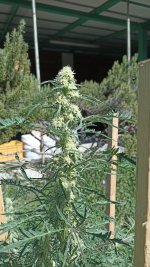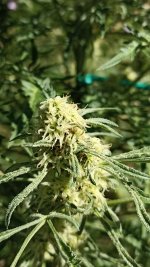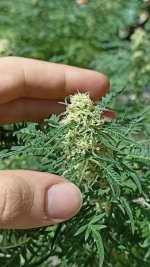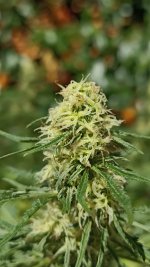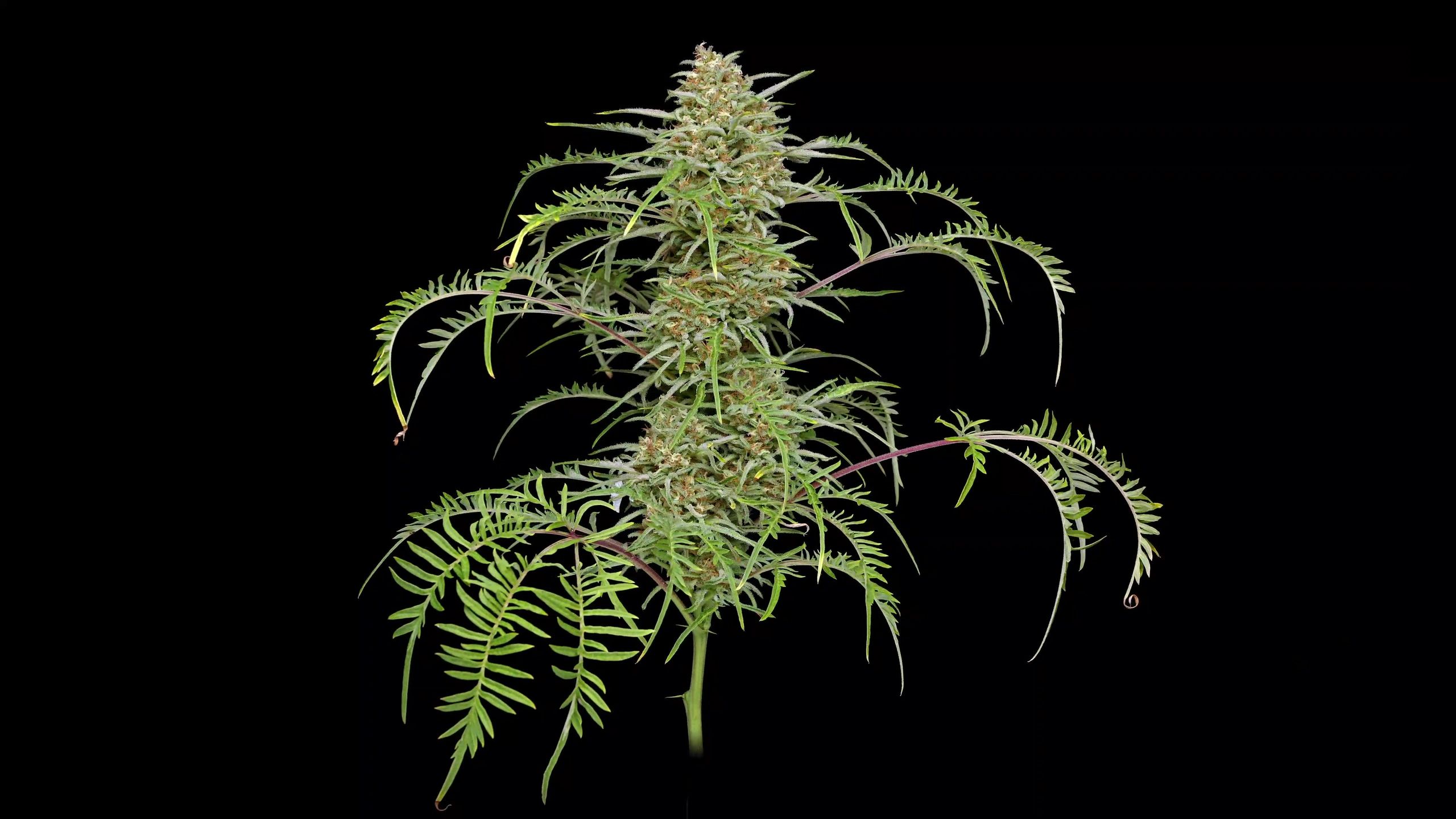IlFattone96
Active member
Ciao a tutti coltivatori!
Ritorno dopo una lunga assenza sia dal foro che dal coltivo (giusto un paio di esperienze in questi anni ma nulla di che).
In realtà sono già attivo da circa inizio aprile, ho acquistato un nuovo box 120x60x200 marca sconosciuta (in precendenza avevo un marshydro 120x120x200) e il vecchio setup:
 ho acquistato delle talee di fanta arancia (selezione Ice Cream Cake di uncle jack) e freakshow di Humboltd (selezione del venditore da cui ho acquistato le talee, pheno tropicallll); una fanta l ho tenuta come mamma da cui prelevare talee e le freakshow da mettere out in terrazzo.
ho acquistato delle talee di fanta arancia (selezione Ice Cream Cake di uncle jack) e freakshow di Humboltd (selezione del venditore da cui ho acquistato le talee, pheno tropicallll); una fanta l ho tenuta come mamma da cui prelevare talee e le freakshow da mettere out in terrazzo.
Prima esperienza nel fare talee, ho utilizzato vasetti con terra light mix, taglio classico a 45°, forbici ben affilate e pulite con alcool, poi gambo passato nella cannella in polvere e messo in terra sotto serretta, umidità 90+ e via; cavo riscaldante se troppo freddo.
Ora vado con jiffy immersi in acqua con stimolatore root della hesi, poi sempre impanati nella cannella in media, se riesco a controllare bene i parametri, un 20 gg e han radicato.
in media, se riesco a controllare bene i parametri, un 20 gg e han radicato.
Diciamo che il cazzeggio con talee mamme ecc è durato un po )alcune talee poi regalate ad amici grower) nel mentre 2 freakshow in vasi da 20 25L light mix, humus e zeolite + rimasuglio di un preparato supersoil stavano crescendo beate in terrazzo; circa a fine luglio si sono aggiunte sul terrazzo due fanta arancia in vasi tessuto da 7.5 lighmix humus zeolite e nell orto una talea di freakshow dopo un combattimento all'ultimo sangue con quel bastardo di un ragno rosso... (Che prosegue tutt'ora
 ) Freakshow dell orto messa in terra piena, scavato buca da circa 25L messo terra buona dell agraria (leggermente prefertilizzata), humus, zeolite, perlite (non sciacquata, non cazziatemi vi prego
) Freakshow dell orto messa in terra piena, scavato buca da circa 25L messo terra buona dell agraria (leggermente prefertilizzata), humus, zeolite, perlite (non sciacquata, non cazziatemi vi prego  ) e guano plagron; successivamente verso metà agosto ho aggiunto una busta di booster per flo di un supersoil acquistato in precedenza + humus e terriccio.
) e guano plagron; successivamente verso metà agosto ho aggiunto una busta di booster per flo di un supersoil acquistato in precedenza + humus e terriccio.
Nel box erano rimaste la mamma di fanta arancia, travasata in un vaso in tessuto da 10 o 11 L circa sempre light mix, e una serretta con talee di vario tipo, fanta, freak, piu altri cut prelevati da piante di amici moby dick (dinafem) e mexican (sensi seeds mi pare).
Appena le talee di fanta erano circa un 20cm, ho selezionato le 5 piu belle e le ho travasate in vasi tessuto da 7.5L light mix + mykos + qualche manciata di humus; utilizzo anche piranha o tarantula (non ricordo ora quale tra i due) 2ml nel foro dove va inserito il panetto durante il trapianto.
Poi ho sistemato le 5 talee di fanta + la mamma nel box 120x60 a vegetare ancora un po, circa 3 settimane; ora ho switchato a 12/12 (cambio diretto, senza scalare ore di luce) il 15 settembre.
Ho avuto anche qualche disavventura con ragno e tripide, un po sono stato cog**ne io a portare cut dall esterno, un po la sfiga che perseguita... Sulle piante out son riuscito a tenere a bada il ragno ma non ad eliminarlo (neem, success, zeolite fogliare), nel box ho avuto un problema tripidi che pare risolto con un prodotto bayern; peccato che poi ho scoperto una talea di fanta nel box con ragno... E le bestemmie partono facili facili
 comunque eliminando foglie e trattando con success + neem pare che ho risolto, PARE perché le uova son sempre dietro l angolo... Volevo prendere un altro prodotto da usare assieme al success, si tratta di un acaricida a base di beauveria bassiana (ceppo 74040) della Naturalis; qualcuno ha gia utilizzato prodotto simile? Se no cosa consigliate da usare assieme al success e neem? Insetti antagonisti?
comunque eliminando foglie e trattando con success + neem pare che ho risolto, PARE perché le uova son sempre dietro l angolo... Volevo prendere un altro prodotto da usare assieme al success, si tratta di un acaricida a base di beauveria bassiana (ceppo 74040) della Naturalis; qualcuno ha gia utilizzato prodotto simile? Se no cosa consigliate da usare assieme al success e neem? Insetti antagonisti?
Cambiando un attimo argomento, volevo condividere come utilizzo il mio setup:
1. Estrattore sempre in funzione (1 velocità) a luci accese e sempre spento di notte, è corretto? Ho il dubbio ma sono comodo in questo modo nel tenere costanti i valori di T e Ur.
2.Ventilatore sempre acceso di giorno, sempre spento di notte come l estrattore.
3. L umidificatore è posizionato al di sotto dei vasi, e il vapore viene sparato dal auo bocchettone originali, quindi nel sottobosco, dovrei forse, tramite un tubo collegato, far si che rilasci il vapore a livello degli apicali?
4. Intrazione passiva, purtroppo non ho proprio modo di portare tramite tubo l aria fresca da fuori, faccio comunque entrare aria nuova nella stanza del grow 2 3 volte al giorno.
5. Fertilizzanti, come accennato prima utilizzo ADV da qualche anno, non ho tutti i prodotti, per ora utilizzo:
Grow micro bloom base
Tarantula, piranha e vodoo
Carboload
Rhino skin
Bug bud
Bud ignitor
Overload
Flawless finish (che mi hanno sconsigliato di usare)
Stimolatore radicale della Hesi.
L' acqua la faccio sempre decantare almeno 24h (salvo alcuni casi dove mi dimentico di riempire il secchio da 5L ), abbastanza dura quella che utilizzo circa 40 gradi francesi, però abbiamo l addolcitore, non so se cambia qualcosa. Ho anche una pompetta ad aria con attaccata una pietra porosa, di solito prima di irrigare la faccio andare mezzoretta in modo da ossigenare l acqua per bene; è inutile come cosa? O meglio farlo dopo aver aggiunto i fert?
), abbastanza dura quella che utilizzo circa 40 gradi francesi, però abbiamo l addolcitore, non so se cambia qualcosa. Ho anche una pompetta ad aria con attaccata una pietra porosa, di solito prima di irrigare la faccio andare mezzoretta in modo da ossigenare l acqua per bene; è inutile come cosa? O meglio farlo dopo aver aggiunto i fert?
Sinceramente non so se in futuro cambiare e passare a supersoil/livingsoil oppure a fert organici di un ottima marca (magari qualcosa di made in Italy); ci stavo gia pensando se partire con un supersoil sto ciclo, ma poi ho visto i fert adv che facevamo polvere nell' armadio e nulla, ho deciso di finire questi prima.
Penso di non aver dimenticato nulla, c'è sempre da imparare, sopratutto dai proprio errori, se vedete qualcosa di errato o poco chiaro non esitate, è sempre un piacere scambiare quattro chiacchere con altri grower, dal vivo purtroppo mi capita raramente...
Domani aggiungo una carrellata di foto in e out poi volevo soffermarmi un attimo sulle freak in vaso sul terrazzo che son belle scariche, e non ho capito bene se son io con la mano troppo leggera oppure c'è un blocco di sali e urge un flusss
poi volevo soffermarmi un attimo sulle freak in vaso sul terrazzo che son belle scariche, e non ho capito bene se son io con la mano troppo leggera oppure c'è un blocco di sali e urge un flusss 
Grazie per chi vorrà seguirmi ed intervenire/consigliare

Buon coltivo a tutti!
Ritorno dopo una lunga assenza sia dal foro che dal coltivo (giusto un paio di esperienze in questi anni ma nulla di che).
In realtà sono già attivo da circa inizio aprile, ho acquistato un nuovo box 120x60x200 marca sconosciuta (in precendenza avevo un marshydro 120x120x200) e il vecchio setup:
- MarsHydro Epistar 160 (fuori produzione da quello che ho visto) ha sulle spalle circa 5 cicli
- Estrattore TT 12.5 blauberg
- Intrazione passiva dagli strap rettangolari del box
- Ventilatore ottima marca 3 velocità
- Umidificatore 5L
- igrometro
- Fertilizzanti ADV (non completo)
- Acqua da rubinetto decantata 24H o piu
Prima esperienza nel fare talee, ho utilizzato vasetti con terra light mix, taglio classico a 45°, forbici ben affilate e pulite con alcool, poi gambo passato nella cannella in polvere e messo in terra sotto serretta, umidità 90+ e via; cavo riscaldante se troppo freddo.
Ora vado con jiffy immersi in acqua con stimolatore root della hesi, poi sempre impanati nella cannella
Diciamo che il cazzeggio con talee mamme ecc è durato un po )alcune talee poi regalate ad amici grower) nel mentre 2 freakshow in vasi da 20 25L light mix, humus e zeolite + rimasuglio di un preparato supersoil stavano crescendo beate in terrazzo; circa a fine luglio si sono aggiunte sul terrazzo due fanta arancia in vasi tessuto da 7.5 lighmix humus zeolite e nell orto una talea di freakshow dopo un combattimento all'ultimo sangue con quel bastardo di un ragno rosso... (Che prosegue tutt'ora
Nel box erano rimaste la mamma di fanta arancia, travasata in un vaso in tessuto da 10 o 11 L circa sempre light mix, e una serretta con talee di vario tipo, fanta, freak, piu altri cut prelevati da piante di amici moby dick (dinafem) e mexican (sensi seeds mi pare).
Appena le talee di fanta erano circa un 20cm, ho selezionato le 5 piu belle e le ho travasate in vasi tessuto da 7.5L light mix + mykos + qualche manciata di humus; utilizzo anche piranha o tarantula (non ricordo ora quale tra i due) 2ml nel foro dove va inserito il panetto durante il trapianto.
Poi ho sistemato le 5 talee di fanta + la mamma nel box 120x60 a vegetare ancora un po, circa 3 settimane; ora ho switchato a 12/12 (cambio diretto, senza scalare ore di luce) il 15 settembre.
Ho avuto anche qualche disavventura con ragno e tripide, un po sono stato cog**ne io a portare cut dall esterno, un po la sfiga che perseguita... Sulle piante out son riuscito a tenere a bada il ragno ma non ad eliminarlo (neem, success, zeolite fogliare), nel box ho avuto un problema tripidi che pare risolto con un prodotto bayern; peccato che poi ho scoperto una talea di fanta nel box con ragno... E le bestemmie partono facili facili
Cambiando un attimo argomento, volevo condividere come utilizzo il mio setup:
1. Estrattore sempre in funzione (1 velocità) a luci accese e sempre spento di notte, è corretto? Ho il dubbio ma sono comodo in questo modo nel tenere costanti i valori di T e Ur.
2.Ventilatore sempre acceso di giorno, sempre spento di notte come l estrattore.
3. L umidificatore è posizionato al di sotto dei vasi, e il vapore viene sparato dal auo bocchettone originali, quindi nel sottobosco, dovrei forse, tramite un tubo collegato, far si che rilasci il vapore a livello degli apicali?
4. Intrazione passiva, purtroppo non ho proprio modo di portare tramite tubo l aria fresca da fuori, faccio comunque entrare aria nuova nella stanza del grow 2 3 volte al giorno.
5. Fertilizzanti, come accennato prima utilizzo ADV da qualche anno, non ho tutti i prodotti, per ora utilizzo:
Grow micro bloom base
Tarantula, piranha e vodoo
Carboload
Rhino skin
Bug bud
Bud ignitor
Overload
Flawless finish (che mi hanno sconsigliato di usare)
Stimolatore radicale della Hesi.
L' acqua la faccio sempre decantare almeno 24h (salvo alcuni casi dove mi dimentico di riempire il secchio da 5L
Sinceramente non so se in futuro cambiare e passare a supersoil/livingsoil oppure a fert organici di un ottima marca (magari qualcosa di made in Italy); ci stavo gia pensando se partire con un supersoil sto ciclo, ma poi ho visto i fert adv che facevamo polvere nell' armadio e nulla, ho deciso di finire questi prima.
Penso di non aver dimenticato nulla, c'è sempre da imparare, sopratutto dai proprio errori, se vedete qualcosa di errato o poco chiaro non esitate, è sempre un piacere scambiare quattro chiacchere con altri grower, dal vivo purtroppo mi capita raramente...
Domani aggiungo una carrellata di foto in e out
Grazie per chi vorrà seguirmi ed intervenire/consigliare
Buon coltivo a tutti!

